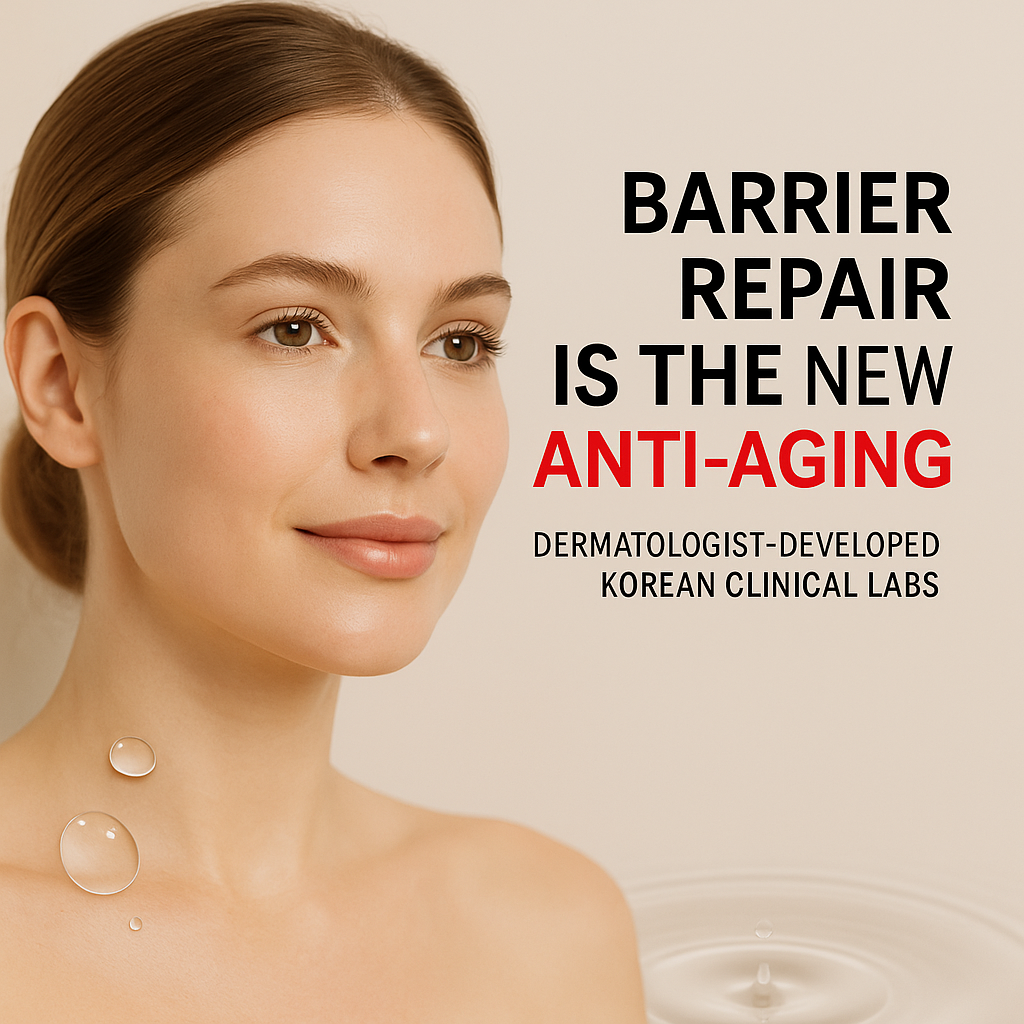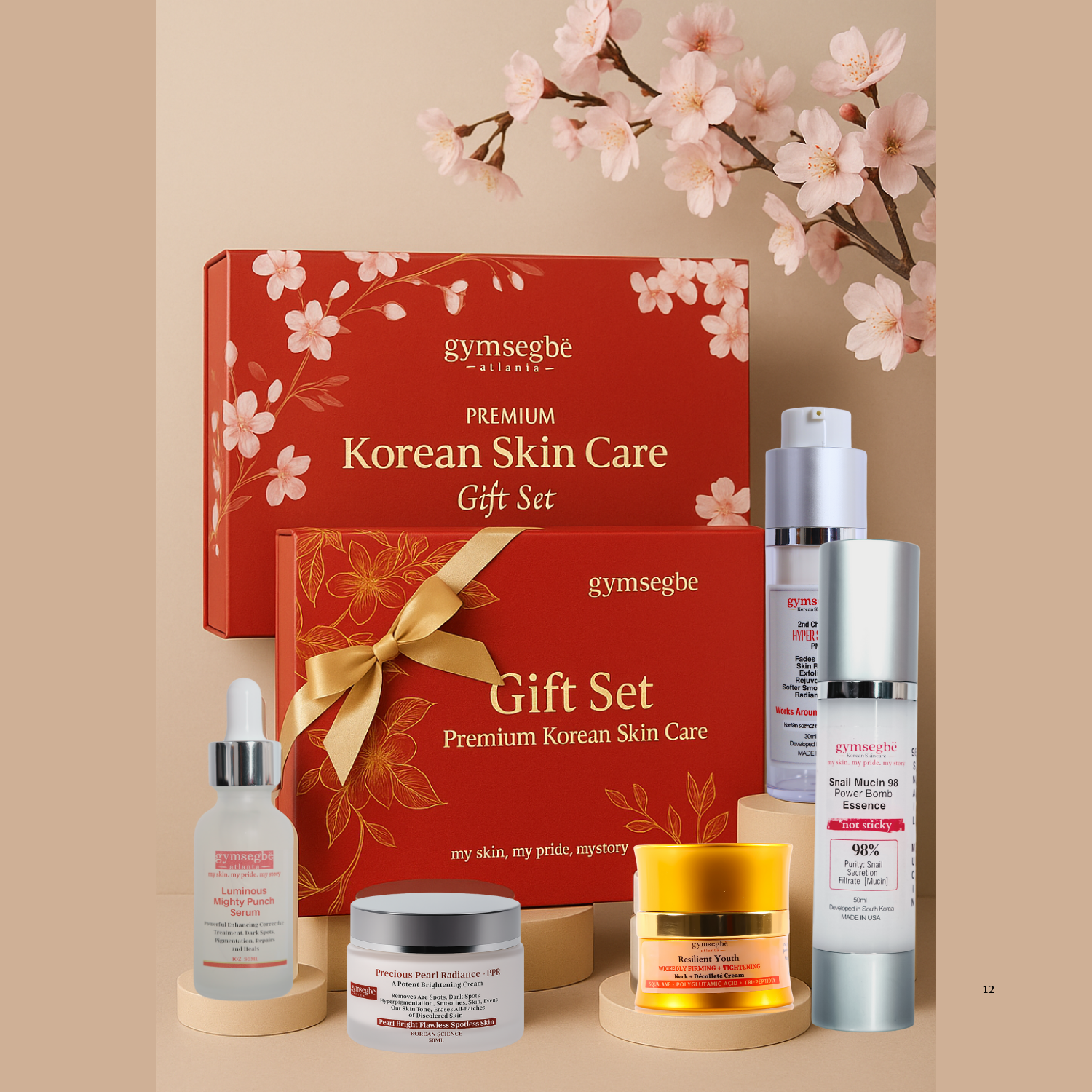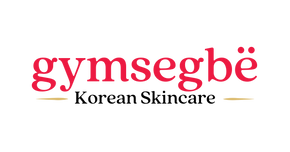Barrier Repair Is The New Anti-Aging

Barrier Repair Is the New Anti‑Aging: What It Actually Means (and How to Do It)
Introduction: When “Less” Becomes More
Trends come and go in the beauty world, but occasionally one signals a profound shift in how we think about skin health. In 2025, barrier repair has become that shift. According to beauty publications like Allure, minimalist skincare routines and barrier‑first care are dominating the year.
Consumers and dermatologists alike are moving away from layering ten different actives and turning toward gentle formulas designed to restore the skin’s natural barrier. This “less is more” philosophy has resonance with self‑care and sustainability. As Allure explains, people are “paring down to just a few products that focus on strengthening the skin’s barrier”.
The renewed focus on the skin’s barrier isn’t just a fleeting trend; it’s rooted in science. When your barrier—consisting of lipids, proteins and ceramides—is intact, your skin retains moisture, fends off irritants and looks naturally plump. When it’s compromised, you experience dryness, redness, sensitivity and accelerated aging. By strengthening the barrier with barrier‑first products, you’re effectively adopting an anti‑aging routine that is gentle yet powerful. Instead of constantly trying to strip, peel or resurface the skin, you’re supporting its natural defenses.
In this article we’ll explain what a healthy barrier is, why barrier repair is considered the new anti‑aging, and how to implement a barrier‑first routine. We’ll also show you how Gymsegbe’s Peptide Moisturizer and Neck/Eye Cream—both formulated with barrier‑restoring ingredients—fit into this minimalist, science‑backed approach.

Why Is Everyone Talking About the Skin Barrier?
Skin science has known for decades that the outermost layer of our skin—the stratum corneum—works like a brick wall. Dead skin cells act as the “bricks” while lipids (ceramides, cholesterol and fatty acids) act as the “mortar” binding them together. This barrier keeps moisture in and environmental aggressors out. When it’s strong, it provides a smooth, plump appearance. When it’s broken down—through over‑exfoliation, environmental damage, harsh cleansers or even stress—it leads to a cascade of problems: dryness, inflammation, fine lines, breakouts and a compromised ability to repair itself.
In 2025, many consumers who previously bought into complicated 10‑step routines and harsh peels are recognizing that constant assault on the barrier can backfire. After all, if you continuously remove the “mortar” from a brick wall, the bricks will crack. Similarly, a compromised barrier ages the skin because it loses moisture and becomes more susceptible to UV damage and pollutants. The best anti‑aging solution may therefore be to stop assaulting the barrier and start nurturing it.
Beauty editors have dubbed this movement “barrier‑first care,” and it’s resonating widely because it solves multiple issues at once. You get a simpler routine (fewer products), less irritation, and better results. Dermatologists also favor this approach. In their offices, they see an increasing number of patients suffering from barrier‑disruption conditions like eczema, rosacea and contact dermatitis, often caused by overuse of strong acids or retinol. Their first piece of advice is usually to pull back, simplify and rebuild the barrier before introducing any potent actives. That advice has trickled down through social media and now informs mainstream beauty culture.
Barrier Repair vs. Traditional Anti‑Aging
Traditional anti‑aging routines often revolve around exfoliating acids (AHAs, BHAs), retinoids and lasers. These tools can be effective, but they work by inducing controlled damage. For skin with a robust barrier, small doses may encourage cell turnover and collagen production. But many people, especially those with sensitive or mature skin, experience more harm than benefit. Dryness, flaking, redness and inflammation are common side effects. When the barrier is compromised, even the most potent anti‑aging ingredients can’t deliver results because the skin is too busy healing itself.
Barrier repair flips the script. Instead of trying to force your skin to look younger through controlled injury, you provide it with the building blocks (lipids, humectants, peptides) to heal itself. Think of barrier repair as strengthening the foundation of your house before painting the walls. Once the structure is solid, you can introduce actives like vitamin C or a gentle retinol if needed.
The results of barrier repair can be more dramatic than you might expect. When the barrier is strong:
- Your skin holds onto moisture better, reducing the appearance of fine lines and wrinkles.
- Inflammation decreases, so redness and hyperpigmentation fade more quickly.
- Your skin is less prone to breakouts because the barrier prevents bacteria from entering.
- Your existing anti‑aging actives (like retinol or peptides) become more effective because the skin can tolerate them better.
- Overall texture improves; the skin feels smoother and looks more radiant.
In short, barrier repair is anti‑aging because healthy skin naturally appears younger.

Minimalist Routines: Why Less Is More in 2025
One of the biggest drivers behind the barrier repair movement is the trend toward minimalist routines. There are several reasons:
- Overuse of actives backfires. People learned the hard way that layering multiple acids and retinoids can trigger chemical burns and chronic irritation.
- Time and money savings. A few high‑quality products replace the need for multiple steps, saving consumers money and time.
- Sustainability. Fewer products mean less packaging and waste, aligning with eco‑conscious lifestyles.
- Mental relief. A simple routine removes decision fatigue. Instead of wondering, “Do I use the green serum before or after the white one?,” you know exactly what your skin needs.
Allure predicts that minimalist, barrier‑first routines will continue to dominate throughout 2025. People want to treat their skin gently while still seeing results. This is where a good peptide moisturizer or eye/neck cream comes in; by delivering a variety of benefits (hydration, barrier support, anti‑aging peptides) in one product, you can simplify while achieving more.
How to Strengthen Your Skin Barrier
Adopting a barrier‑first routine involves a few key principles:
1. Cleanse Gently
Skip harsh foaming cleansers. Choose a low‑pH, sulfate‑free cleanser that removes impurities without stripping natural oils. If you wear heavy makeup or sunscreen, double cleanse using an oil-based cleanser followed by a gentle gel or cream cleanser. Limit hot water, which can also deplete lipids.
2. Replenish Lipids and Humectants
To rebuild the “mortar” between your skin’s cells, look for products containing ceramides, cholesterol and fatty acids. These lipids mimic the skin’s natural barrier components. Humectants like glycerin and hyaluronic acid attract water into the skin, while occlusives like squalane prevent water loss.
3. Soothe and Reduce Inflammation
Barrier dysfunction often coexists with inflammation. Ingredients like niacinamide (vitamin B3), Centella asiatica, green tea and colloidal oatmeal reduce redness and support healing. Antioxidants also help neutralize free radicals that cause inflammation.
4. Support With Peptides
Peptides are short chains of amino acids that can signal the skin to produce more collagen or elastin. They help improve firmness, reduce fine lines and strengthen the barrier by improving the integrity of the skin’s outer layer. When combined with barrier‑repair ingredients, peptides amplify anti‑aging benefits without causing irritation.
5. Protect With Sunscreen
A strong barrier is still vulnerable to UV damage. Daily broad‑spectrum SPF 30 or higher prevents sunburn, photoaging and further barrier degradation. Choose a sunscreen with moisturizers and antioxidants to further support the barrier.
6. Introduce Actives Carefully
If you wish to use acids or retinol, start slowly and ensure your barrier is healthy first. Use a gentle formula and buffer with hydrating products. Always follow instructions, monitor for irritation, and stop if you experience prolonged discomfort.

Barrier Repair Ingredients to Look For
To build a successful barrier‑first routine, look for the following key ingredients:
- Ceramides (e.g., Ceramide NP) – Naturally occurring lipids that fill the gaps between skin cells. They help prevent transepidermal water loss.
- Fatty acids (e.g., linoleic acid, squalane) – Provide emollient properties and support the lipid layer.
- Ectoin – A stress‑protecting molecule that enhances the skin’s ability to retain moisture and protect from environmental aggressors.
- Niacinamide – Strengthens the barrier, reduces redness and regulates sebum production.
- Hyaluronic Acid – Attracts and retains water, delivering plumping hydration.
- Peptides – Stimulate collagen and elastin, support wound healing and firm the skin.
- Antioxidants – Protect from oxidative stress and help calm inflammation.
Gymsegbe’s Peptide Moisturizer and Neck Cream/Eye Cream combine many of these ingredients, creating a multi‑benefit product designed specifically for barrier support and anti‑aging.
Gymsegbe’s Barrier‑First Heroes
At Gymsegbe, we design formulas that embody the barrier‑first philosophy. Our products are dermatologist‑developed in South Korea and focus on addressing multiple concerns simultaneously without overloading the skin. Let’s explore two of our star products:
Peptide Moisturizer
This lightweight cream is rich in barrier‑strengthening ingredients. We combined Ceramide NP—a skin‑identical lipid—with Ectoin, a natural molecule that protects against environmental stress and reinforces the moisture barrier. Our peptide blend includes peptides complex known to improve skin elasticity and reduce fine lines, while squalane and hyaluronic acid lock in hydration.
Unlike many thick barrier creams, Gymsegbe’s Peptide Moisturizer feels silky and absorbs quickly, making it perfect for both day and night. A supportive barrier means you can tolerate other actives better—so if you want to layer a gentle retinol after your skin has healed, you’ll experience fewer side effects. Paired with daily SPF, this moisturizer delivers the perfect balance of barrier care and anti‑aging.

Neck Cream/Eye Cream
It’s easy to forget that the skin on your neck and around your eyes is thinner and more prone to early aging. Our Neck Cream/Eye Cream addresses both areas with a multi‑peptide complex and barrier‑supporting lipids. The formula includes:
- Multi‑Peptides – Improve elasticity and smooth fine lines.
- Ceramides and Cholesterol – Mimic natural skin lipids to strengthen the barrier.
- Hydrating Botanicals – Such as aloe and green tea for soothing effects.
- Antioxidants – Protect delicate skin from environmental damage.
When used consistently, this cream helps firm and lift the neck area while minimizing crow’s feet. Since the formula is non‑irritating, you can apply it twice daily without causing dryness or peeling. As part of a minimalist routine, this targeted treatment ensures that even sensitive areas receive barrier‑first care.
Putting It All Together: A Sample Barrier‑First Routine
Now that you understand the principles of barrier repair and the key ingredients to look for, here’s a sample routine using Gymsegbe products to simplify your skincare while maximizing results:
-
Morning
- Cleanse with a gentle cleanser (optional if you cleanse thoroughly at night).
- Apply Dynamic Toner or another hydrating toner.
- Pat in Snail Mucin 98 Essence to deeply hydrate and calm.
- Apply Luminous Mighty Punch Serum (niacinamide + antioxidants). Allow it to absorb.
- Follow with Peptide Moisturizer for barrier support and hydration.
- Finish with a broad‑spectrum SPF 50 (we recommend Gymsegbe’s sunscreen) to protect the repaired barrier from UV damage.
-
Evening
- Double cleanse (oil cleanser + gentle cleanser) if wearing makeup or sunscreen.
- Apply toner and essence as in the morning.
- Use Neck Cream/Eye Cream on the delicate neck and eye areas.
- Apply Peptide Moisturizer.
- Optionally layer a gentle retinol or other active once your barrier is healthy (start with twice a week). If your skin is sensitive, skip the retinol until your barrier is fully restored.
-
Weekly
- After a few weeks of barrier healing, incorporate the Thick as Thieves Glycolic–Lactic Acid Peel once a week to gently exfoliate dead skin cells and promote brightening. Always follow with the essence and Peptide Moisturizer.
Stick with this simplified routine for at least six weeks. You may notice that after a couple of weeks, your skin feels smoother, redness fades and you need less foundation. Continue to use sunscreen daily to protect your results. Once your barrier feels strong, you can introduce additional actives (like vitamin C or retinol), but always do so gradually and patch test first.

Conclusion: A New Era of Anti‑Aging
The concept of barrier repair represents a paradigm shift in how we approach anti‑aging. Rather than waging war on your skin with harsh acids and peels, barrier‑first care invites you to listen to your skin and nurture its natural defenses. Minimalist routines focused on replenishing lipids, hydrating deeply and incorporating peptides have proven to produce healthier, smoother and younger‑looking skin.
As 2025 continues, we anticipate that more people will embrace this science‑backed approach. They’ll streamline their routines, invest in quality products and focus on long‑term skin health rather than quick fixes. Our peptide‑rich moisturizer and neck/eye cream are formulated to accompany you on this journey—combining barrier‑strengthening ingredients with peptides for a holistic anti‑aging solution.
Remember, the ultimate goal of skincare isn’t just to look good; it’s to feel good. When your barrier is healthy, your skin feels comfortable and confident. As the Allure article hints, barrier‑first routines signal self‑care and empowerment.
You deserve to experience the joy of a simple routine that yields transformative results. Join the barrier repair movement and let your skin thrive in 2025 and beyond.
Barrier-First Skincare FAQ
1) Barrier Basics
What is the skin barrier?
How do I know my barrier is damaged?
- Tightness or stinging after cleansing
- Flaking, rough patches, makeup pilling
- Frequent redness/heat flush
- Breakouts that heal slowly or mark easily
- Increased sensitivity to sun/actives
Which ingredients strengthen the barrier?
2) Routine & Order
What’s the correct order to apply products?
- Toner (hydrate/balance)
- Essence (deep water repair)
- Serum (niacinamide/targeted)
- Peptide Moisturizer (ceramide NP + ectoin)
- AM only: SPF 50
AM vs PM—what changes?
How long should I wait between layers?
3) Actives & Exfoliation
Can I use acids or retinoids while repairing?
How often should I exfoliate?
What not to combine on the same night?
- Retinoid + strong AHA/BHA
- High-strength vitamin C + strong acids
- Multiple new actives at once
4) Results & Troubleshooting
When will I see results?
- 3–7 days: better comfort & hydration
- 7–14 days: calmer tone, fewer dry patches
- 3–4 weeks: smoother texture, brighter look
Everything stings—what do I do?
Do I still need moisturizer if I’m oily?
5) Products & Ingredients (Gymsegbe)
Which Gymsegbe products form the core barrier-first routine?
- Hydrating Toner / Essence
- Luminous Mighty Punch (niacinamide + soothing botanicals)
- Peptide Moisturizer (ceramide NP + ectoin + multi-peptides)
- Habaek SPF50 Moisturizer (broad-spectrum + peptide/soothing support)
















